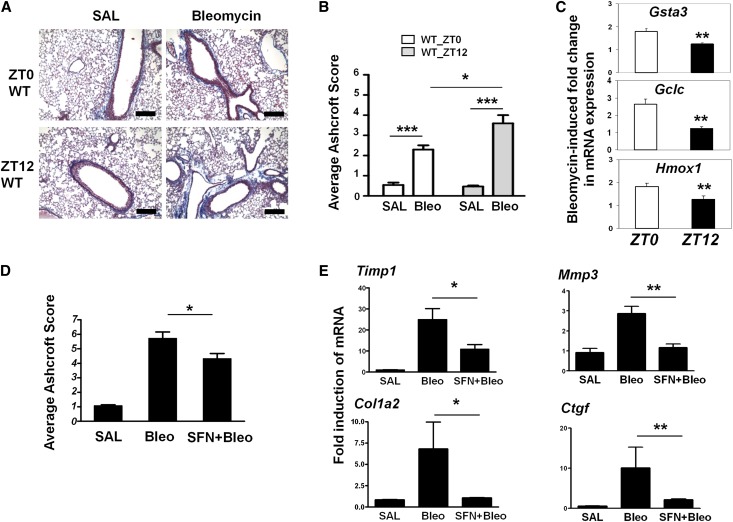Figure 4.
Time-of-day-dependent lung response to bleomycin challenge is coupled to temporal NRF2 activity. (A) Representative mouse lung sections were stained with Masson's Trichrome solution to reveal collagen fiber deposition (blue staining) and overall fibrosis. Wild-type (WT) mice were treated with bleomycin (n = 8) or saline (n = 5) at either ZT0 or ZT12 and, 7 d later, were sacrificed for tissue processing. Bar, 200 μM. (B) Lung sections in A were scored for fibrosis according to the Ashcroft scoring system. Mean ± SEM; (***) P < 0.001, saline versus bleomycin, t-test; (*) P < 0.05, ZT0 versus ZT12, two-way ANOVA. (C) Fold induction in wild-type lung mRNA levels of NRF2 targets (Gclc, Gsta3, and Hmox1) following bleomycin delivered at ZT0 or ZT12. Data (mean ± SEM) were expressed relative to saline controls at the respective time points. (**) P < 0.01, two-way ANOVA. (D,E) SFN treatment partially rescues the lung fibrosis phenotype, as revealed by Masson's Trichrome staining (with lower Ashcroft score) and reduced gene induction for fibrotic markers (Timp1, Col1a2, Mmp3, and Ctgf). Wild-type mice were treated with either saline (n = 3), bleomycin (n = 4), or SFN plus bleomycin (n = 5) and, 7 d later, were sacrificed for histological and gene expression analysis. Mean ± SEM; (*) P < 0.05; (**) P < 0.01, t-test.

